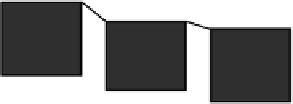Biomedical Engineering Reference
In-Depth Information
100%
0.70
0.75
0.80
0.85
0.90
0.95
90%
80%
70%
60%
50%
40%
30%
20%
10%
0%
Best SI*
NMI nonrigid
NMI affine
DEF max
DEF avg
Criterion for Most Similar Atlas
Figure 11.7: Percentages of structures segmented with accuracy better than
given SI thresholds using different “most similar” atlas selection criteria. Each
column represents one criterion (see text for details). The stacked bars from
bottom to top show the percentages of structures that were segmented with SI
better than 0.95 through 0.70. For comparison, the left-most column shows the
results when the atlas with the best a posteriori SI segmentation result is used
for each raw image. This is the upper bound for the accuracy achievable with
any criterion for selection of the best single individual atlas.
the atlas candidates was chosen using each of the criteria above. The accuracy
of a segmentation was computed as the SI between the segmentation and the
manual gold standard.
Figure 11.7 shows a graph of the percentages of structures segmented with
varying levels of accuracy. For comparison, this graph includes results achieved
when using the best atlas according to the a posteriori SI values for each raw
image (left-most column,
Best SI
). In other words, this column shows the best
possible result that can be achieved using only a single individual atlas, where the
selection of this atlas is governed by the knowledge of the resulting segmentation
accuracy (SI value). Obviously, this is not a strategy that is available in practice.
However, it provides the upper bound for the segmentation accuracy that can
be achieved using any criterion for selection of the best atlas for a given raw
image.




















